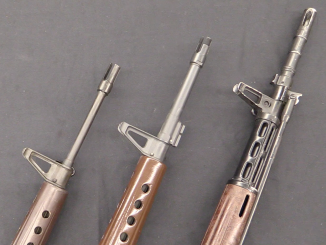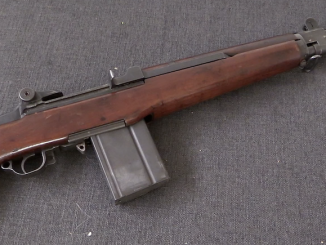The M1895 Lee Navy was a rifle well ahead of it’s time – a smallbore (6mm) straight-pull bolt action adopted by the US Navy at the same time that the US Army was adopting the Krag-Jorgenson. The Lee Navy was designed by James Paris Lee (the same man who designed the Lee Enfield action), and was a limited commercial success for Winchester with 20,000 being sold in total. Half of those went to the US Navy, and they were issued to shipboard armories and Marine Corps units. One of the ships which received an allotment of Lee Navy rifles was the USS Maine, and its rifles were on board when she exploded and sank in the Havana harbor, helping to start the Spanish-American War. Several dozen of these rifles were salvaged shortly after the sinking (it happened in less than 50 feet of water) and were sold on the commercial market by the Francis Bannerman company. This rifle is one of those few documented to have come off the Maine, making it a fantastic piece of history.
Related Articles

Select-fire Rifles
Evolution of the Dutch-Made AR10
The AR-10 rifle was developed in the United States (Hollywood California, specifically) by Eugene Stoner, but the Armalite company did not have a suitable large scale manufacturing facility to produce the number of guns they […]

Semiauto Rifles
Vintage Saturday: Prior Planning Prevents Piss-Poor Performance
Cuban exiles training in Florida for the Bay of Pigs invasion, with scoped M1941 Johnson rifles. (coming Monday, a video on the Johnson…)

Conversion
Erquiaga EM-62: Castro’s Ex-Armorer Makes an M14
Juan Erquiaga was a Peruvian Army officer who was introduced to Gordon Ingram and the Police Ordnance Company, probably during Ingram’s time working on sales of the Model 6 submachine gun to Peru. Erquiaga first […]

Considering that it had been immersed in salt water for a period of time prior to salvage, this rifle is in remarkably good condition, a testament to the diligence of the salvors and armorers who must have known about the dire consequences of exposure to air after immersion, and who took the necessary steps to prevent the onset of major corrosion during the salvage and rehabilitation processes.
This James D Julia auction seems to have more than its fair share of historically interesting and special firearms. For once, in firearms context, I am not sorry for not living in the US, since I couldn’t afford those guns anyways…
Did the USN really think about torpedo boats when they wanted a more powerful cartridge than the .30-40 Krag? I find that somewhat hard to believe. The typical anti-torpedo boat guns in the 1890s were 37mm and 47mm guns, which were soon found to be insufficient for the job, so firing a rifle at a torpedo boat would seem kind of futile.
By the way Ian, you have copy pasted the same mistake here you originally had at full30.com: “Christopher Lee” should be “James Paris Lee”.
Name mistake has been fixed.
This Julia auction includes a couple major collections that explain the number of interesting guns – Elmer Keith’s, part of Geoffrey Sturgess’, and part of the Evergreen Aircraft Museum machine gun collection (among others).
I’m wondering how it is possible that US Navy and US Army adopted in similar time (1892 and 1895) two different rifle cartridges. Do you know any other example when Navy and Army adopted two different cartridges?
“they wanted a more powerful cartridge than the .30-40 Krag? I find that somewhat hard to believe”
Do anybody of you have information about penetration of steel (or iron) plate penetration by standard-issue 6mm Lee-Navy?
“Lee Navy was a rifle well ahead of it’s time – a smallbore (6mm)”
Also it is noteworthy that 6mm Lee Navy is parent of .220 Swift cartridges, which when introduced in 1935, was fastest commercial available American rifle cartridge. Notice that even it was introduced 40 years later than 6mm Lee-Navy its was known for short barrel life.
Back then the War Dept (Army) and the Navy Dept were two completely different groups. Back then the army was really focused on protecting the territory of the country, while the Marines were the ones who went overseas.
Even today, if I’m not mistaken the US Navy never adopted (or if it has, it waited a while) the 9mm or the 5.56.
“the Marines were the ones who went overseas”
Concerning that 6mm Lee-Navy has one more important advantage: 6mm Lee-Navy cartridge is lighter that .30-40 Krag, http://en.wikipedia.org/wiki/M1895_Lee_Navy states that 220 Lee-Navy and 160 .30 Army cartridges has roughly the same mass. This advantage was more crucial for Marines which supply chain can be easier cutted.
Naval ships carry rifles for landing parties and guard duties
The fact that “squids” were issued rifles is a story in it self. Sailors actually detonated incoming torpedoes with one shot.
Wow, what an amazing piece of history. I think it’s great that one can still purchase and own something of such significance. I also agree that the rifle in the video seems quite well preserved considering what it has been through. I have a Lee Navy, but not one with that kind of provenance, but I do have ammo. Now if I could just find some torpedoes to shoot at… 🙂
Lee Penetration
135 gr CN plated steel jacket bt @2460 fps at 5 ft
62 1″ pine boards
7/16″ boiler plate
30-40 Krag
220 gr bt @2000 fps
45 1″ pine boards
Interesting action, but was that lug on the right side of receiver only thing holding it locked? If yes, eeek, no I would not like to fire such hot cartridge from it…
A perfect example of toggle lock. Most preferred mechanism on high pressure manufacturing presses.
The Navy tested the (then experimental) calibre .30 round in 1891. It had not yet been adopted for Army use (that came the following year). At that time the bullet and load was still being worked on, as there were problems with stripping. The version the Navy tested, the “Board cartridge” was loaded with a 230 gn copper jacketed bullet, and the Navy ordered 500 rounds for testing it in a Mauser rifle. They then experimented with a .32 calibre round, in both rimmed and rimless versions, with a 235 gn bullet at about 1600 fps in 1892-3. This was then dropped and, after an investigation, the Navy’s Caliber Reduction Board recommended a 6mm round in its report of 31 July 1893. The key factors were penetration of enemy boat hulls, flat trajectory, reduced recoil and an increase in the number of rounds each man could carry. The initial round approved for testing a new rifle was in a rimmed case, with a 135 gn steel-jacketed bullet, and this bullet could penetrate 3/8″ boiler plate at 100′. The decision was then made to go with a rimless (or semi-rimmed) case, and later the bullet weight was reduced to 112 gn with a copper jacket replacing the steel, improving trajectory and reducing bore wear respectively.
FWIW the US Ordnance also considered calibres smaller than .30 during the mid 1890s, and in 1895 tested an experimental .22 calibre based on a modified .30-40 case, with bullets of 112gn, 118 gn and 120 gn. The 120 gn was loaded to a muzzle velocity of about 2600 fps.
Whatever happened to the Lee Navy you guys got for destructive testing with resized .30-40 Krag handloads? Is that still ongoing?
http://www.spanamwar.com/mainsalv.htm Salvage and Final Voyage of the U.S.S. Maine
Naval vessels always carry small arms for boarding parties, vessel defense in port, guard duties ashore and on board, mutinies, etc.
Even submarines (past and present) carry some small arms.
Their purpose definitely is not surface vessel combat.
https://flic.kr/p/cac8ps
I just so happen to have a Bannerman catalog with a page about the rifles that company sold….
Speaking the “Maine”, I fairly recently came across an article which offered as one explanation the possibility that the coal (as the one used to heat the boilers of the “Maine”) under certain conditions – high temperatures, high humidity – might produce the spontaneous combustion.
I hope this isn’t too far off topic…
I have a nice Lee Navy that has this on the receiver ring:
U.S.N.
No 15xx
-N.C.T.-
I can’t find any other numbers or significant marks on the receiver above the wood (haven’t looked under it yet). This low number doesn’t agree with s/n ranges I’ve read about these rifles.
Anyone have any info or ideas about this rifle?
Thanx, guys.
I forgot to add that the markings include a navy anchor between the first and second line.